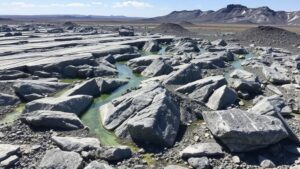Spotting High-Yield Gravel Deposits in Remote Streambeds for Gold Recovery
Spotting High-Yield Gravel Deposits in Remote Streambeds for Gold Recovery
Gold prospecting has captivated many for centuries, compelling individuals to sift through riverbeds in search of this precious metal. Although several methods exist for gold recovery, locating high-yield gravel deposits in remote streambeds is a critical first step. This article aims to provide an in-depth education on how to effectively identify these deposits, supported by concrete examples and best practices in the field.
The Importance of Gold Locations
Understanding where to look for gold is essential for successful prospecting. Gold typically migrates to lower-velocity areas in streams where the water slows down enough for it to settle. Notably, floodplains and the inside bends of meanders often become prime locations for gold deposits.
Key Characteristics of High-Yield Gravel Deposits
When scouting for potential spots, several characteristics can indicate the presence of high-yield gravel deposits:
- Gravel Size and Composition: Look for gravel that is well-rounded and mixed with larger boulders. This mixture signals that the area has undergone significant water flow, allowing heavier materials, like gold, to settle.
- Coloration: Darker gravel often suggests higher mineral content and the potential presence of precious metals. Discoloration may occur due to clay or other minerals mixed in.
- Structural Features: Features such as riffles, pools, and eddies are key indicators. Riffles slow down water flow, allowing gold to settle in the gravel behind these structures.
Techniques for Locating High-Yield Deposits
To identify high-yield gravel deposits more effectively, several techniques can be employed:
- Surface Sampling: Use a metal pan or small shovel to sample gravel from various locations. Pay attention to areas near pools, riffles, and the base of larger rocks.
- Gold Panning: This traditional method can yield quick results. Fill a pan with gravel, submerge it in water, and shake to separate lighter materials from gold.
- Hydraulic Sluicing: For larger operations, using a sluice box can be effective. Water flows through the sluice, which captures gold from gravel as the lighter material washes away.
Case Studies and Success Stories
Throughout history, there have been numerous examples of successful gold prospecting based on the identification of high-yield deposits:
- California Gold Rush (1848-1855): Prospectors flocked to areas like the Feather River and American River, where high-yield gravel deposits were discovered, leading to significant gold finds.
- Klondike Gold Rush (1896-1899): The discovery of gold along Bonanza Creek showcased the success achieved through identifying prime locations in riverbeds that exhibited favorable geological features.
Challenges and Considerations
Finding high-yield deposits is not without its challenges. It is important to consider:
- Environmental Impact: Prospecting can disrupt local ecosystems. Always ensure compliance with regulations to minimize harm.
- Seasonal Variations: Water flow can significantly change with seasons, affecting accessibility and deposit distribution. Late spring or early summer are often optimal times for prospecting.
- Legal Restrictions: Ensure that mining activities comply with local laws and regulations. Research claims and permits in advance to avoid legal issues.
Actionable Takeaways
To wrap up, identifying high-yield gravel deposits in remote streambeds for gold recovery requires a combination of field knowledge, practical techniques, and an understanding of environmental considerations. By focusing on key characteristics, employing effective sampling methods, and drawing on historical case studies, aspiring prospectors can improve their chances of success.
To begin your prospecting journey, remember to:
- Study local geology to understand where gold is most likely located.
- Employ various techniques such as gold panning and sluicing to maximize recovery.
- Stay informed about environmental regulations to ensure sustainable practices.
Armed with this knowledge, new and experienced prospectors alike can venture into the wilderness with greater confidence in their search for gold.

